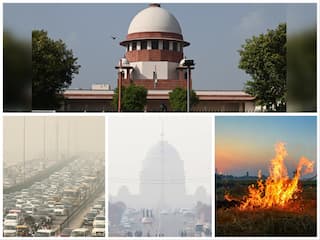Supreme Court Expresses Discontent Over Inaction on Delhi Air Pollution Crisis

Supreme Court Expresses Discontent Over Inaction on Delhi Air Pollution Crisis
New Delhi, October 3, 2024 — The Supreme Court of India today expressed deep concern and frustration over the ineffective handling of the ongoing air pollution crisis in Delhi, describing it as a “harsh reality that nothing is happening.” This stark remark came during a hearing, where the Court took note of the alarmingly high pollution levels and the lack of concrete action by the authorities.
A bench led by Chief Justice of India, along with Justices S.K. Kaul and Sudhanshu Dhulia, questioned the functioning of the Commission for Air Quality Management (CAQM), the apex body responsible for formulating and overseeing strategies to mitigate pollution in the National Capital Region (NCR). The Court observed that the CAQM had convened only three meetings in the past nine months, despite the mounting severity of pollution in Delhi and surrounding areas.
Inaction Amid Crisis
The Supreme Court expressed dissatisfaction with the inadequate number of meetings, emphasizing that the worsening air quality required urgent, sustained efforts. “This is not just a bureaucratic exercise; people are dying. Why are only three meetings held in nine months?” asked the Chief Justice.
Delhi has long been plagued by severe air pollution, especially during the winter months when particulate matter levels skyrocket due to a combination of factors, including crop residue burning in neighboring states, vehicular emissions, and construction activities. The air quality index (AQI) in the city frequently crosses hazardous levels, posing serious health risks to residents.
The Court was particularly critical of the CAQM’s limited engagement, saying, “It is disappointing that a key panel designed to address one of the gravest environmental issues in the country is functioning in such a lackadaisical manner.”
The Government’s Defense
In response, Solicitor General Tushar Mehta, representing the Centre, stated that various initiatives had been undertaken to combat air pollution, but admitted that challenges remained. He pointed to ongoing measures such as the promotion of electric vehicles, stricter enforcement of emission standards, and anti-smog gun installations. However, the Court was not satisfied with these explanations, demanding a more robust action plan and its timely execution.
Looking for Accountability
In a direct message to the CAQM, the Court insisted on more frequent meetings and timely reports on the status of actions taken. “The situation cannot continue like this. Accountability must be ensured,” the bench remarked, adding that the health and well-being of Delhi’s population must be a priority for the government.
The Court further directed the government to present a detailed report outlining the steps taken in the next two weeks, failing which it would consider taking stricter actions.
A Looming Health Crisis
With winter approaching, concerns over Delhi’s air quality are intensifying. The annual phenomenon of stubble burning in Punjab and Haryana, combined with seasonal changes, often leads to toxic smog blanketing the region. Despite years of legal battles and action plans, the air pollution problem continues to pose a serious threat to public health, with long-term consequences for the city’s population.
As the hearing concluded, the Court’s closing remarks captured the urgency of the issue: “It is not just a problem for the future; it is a disaster unfolding in the present. We cannot afford to wait any longer.”